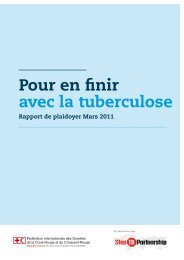Thailand - Stop TB Partnership
Thailand - Stop TB Partnership
Thailand - Stop TB Partnership
Create successful ePaper yourself
Turn your PDF publications into a flip-book with our unique Google optimized e-Paper software.
tool for the NTP to improve its access to marginalized groups such as migrant workers,<br />
ethnic minorities, and former prisoners. 152<br />
Collaboration with multilateral organizations and<br />
bilateral donors<br />
Over 90 percent of the national response to <strong>TB</strong> and <strong>TB</strong>/HIV is funded from the government<br />
budget and out-of-pocket spending. 153 Thai <strong>TB</strong> experts insist that assistance from bilateral<br />
and multilateral donors should reinforce national health systems and contribute to health<br />
policies and programming that are sustainable in the long term.<br />
Participants at one roundtable meeting unanimously emphasized the importance<br />
of balancing donor interests and requirements with the need for funded projects<br />
to complement existing structures and programs. For example, one prominent regional<br />
health administrator insisted that donor-supported <strong>TB</strong> projects must support the NTP, take<br />
steps to ensure support from the communities in which they are to be implemented, and<br />
avoid replacing essential <strong>TB</strong> control activities and functions that should be managed by the<br />
Thai government. In the administrator’s view, the NTP must always be able to “do without<br />
donor-supported supplemental activities if it has to.” 154 For this reason, some health officials<br />
express concern about the fact that Global Fund resources have supported such core activities<br />
as training programs for health workers, which have not received sufficient funding<br />
from the NTP since the health reforms. They emphasize that these resources should be seen<br />
by the NTP only as a short-term opportunity to build a stronger base for programs that will<br />
have to be continued without donor funding in the future. 155<br />
There are positive examples of donor projects that fulfill these requirements in the<br />
eyes of their Thai partners. For example, the director of one Bangkok-based health center<br />
identified a collaborative project with the U.S. Centers for Disease Control and Prevention<br />
in which the donor organization arrived with one idea of what to fund, but proved willing to<br />
change the parameters of the project in response to local feedback and suggestions on what<br />
was needed. The result was a PPM DOTS program that has posted significant successes,<br />
enjoys strong local support, and provides a strong basis for scaling-up. It demonstrates the<br />
benefits of international donor/public sector partnerships that are firmly rooted in the communities<br />
they serve and that can provide a long-term return on a short-term investment. 156<br />
Another donor organization that has adapted the assistance it provides to locally<br />
identified needs is the Research Institute of Tuberculosis (RIT) in Japan. The RIT has<br />
provided long-term support for the improvement of laboratory capacity, provincial-level<br />
PUBLIC HEALTH WATCH MONITORING REPORTS 65


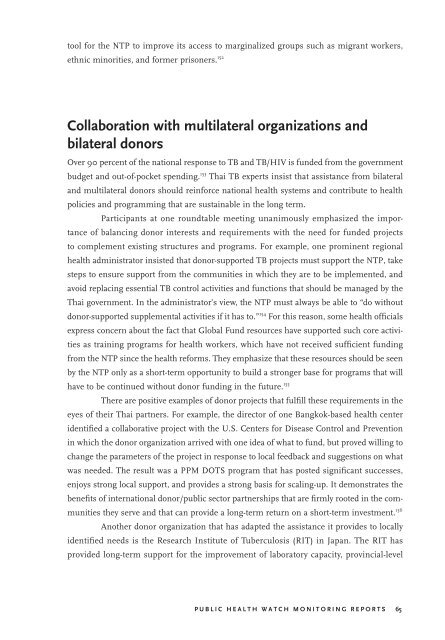
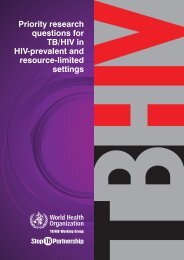
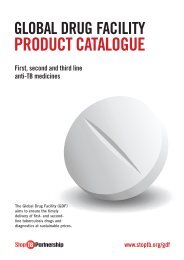
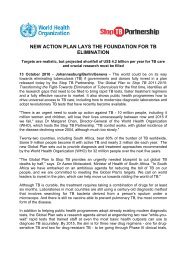

![Global Drug Facility Annual Report 2011 [.pdf] - Stop TB Partnership](https://img.yumpu.com/26788745/1/184x260/global-drug-facility-annual-report-2011-pdf-stop-tb-partnership.jpg?quality=85)

![Concept note on national stop TB partnership [.pdf]](https://img.yumpu.com/26788741/1/184x260/concept-note-on-national-stop-tb-partnership-pdf.jpg?quality=85)


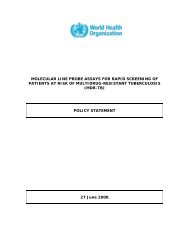
![2005 and Challenges for 2006 - 2015 [.pdf] - Stop TB Partnership](https://img.yumpu.com/26788674/1/190x245/2005-and-challenges-for-2006-2015-pdf-stop-tb-partnership.jpg?quality=85)
![Brochure (French) [.pdf] - Stop TB Partnership](https://img.yumpu.com/17234792/1/190x91/brochure-french-pdf-stop-tb-partnership.jpg?quality=85)

